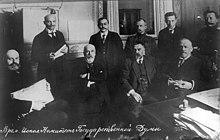
Back حكومة روسيا المؤقتة Arabic حكومة روسيا المؤقته ARZ Gobiernu provisional rusu AST Rusiya müvəqqəti hökuməti AZ Часовы ўрад Расіі BE Часовы ўрад Расеі BE-X-OLD Временно руско правителство Bulgarian Govern Provisional Rus Catalan Ruská prozatímní vláda Czech Den russiske provisoriske regering Danish
Russian Provisional Government Временное правительство России | |||||||||
|---|---|---|---|---|---|---|---|---|---|
| 1917 | |||||||||
| Anthem: Рабочая Марсельеза Rabočaja Marseĺeza "Worker's Marseillaise" Gimn Svobodnoj Rossii "Anthem of Free Russia" (unofficial) | |||||||||
| Government Seal: | |||||||||
| Capital | Petrograd | ||||||||
| Common languages | Russian | ||||||||
| Demonym(s) | Russian | ||||||||
| Government | Provisional government | ||||||||
| Minister-Chairman | |||||||||
• Mar-Jul 1917 | Georgy Lvov | ||||||||
• Jul-Sep 1917 | Alexander Kerensky | ||||||||
| Legislature | Provisional Council | ||||||||
| Historical era | World War I | ||||||||
| 8–16 March 1917 | |||||||||
| 10–13 September 1917 | |||||||||
• Republic proclaimed | 14 September 1917 | ||||||||
| Currency | Ruble | ||||||||
| |||||||||
Russian Provisional Government | |
|---|---|
9th Cabinet of Russia | |
 | |
| Date formed | 2 March [15 March, N.S.] 1917 |
| Date dissolved | October [November, N.S] 1917 |
| People and organisations | |
| Head of state | Alexis II (unproclaimed) Michael II (conditionally) |
| Head of government | Georgy Lvov |
| Member parties | Progressive Bloc Socialist-Revolutionaries Mensheviks Popular Socialists |
| Status in legislature | Coalition |
| Opposition cabinet | Executive Committee of Petrograd Soviet |
| Opposition parties | Bolsheviks Left Socialist-Revolutionaries |
| Opposition leader | Nikolay Chkheidze |
| History | |
| Incoming formation | Golitsyn |
| Outgoing formation | Kerensky I |
| Predecessor | Nikolay Golitsyn |
| Successor | Alexander Kerensky |

Seated: V. N. Lvov, V. A. Rzhevsky, S. I. Shidlovsky, and M. V. Rodzianko (Chairman);
Standing: V. V. Shulgin, B. A. Engelhardt, A. F. Kerensky, and M. A. Karaulov.
The Russian Provisional Government[a] was a provisional government of the Russian Empire and Russian Republic, announced two days before and established immediately after the abdication of Nicholas II.[1] The intention of the provisional government was the organization of elections to the Russian Constituent Assembly and its convention. The provisional government, led first by Prince Georgy Lvov and then by Alexander Kerensky, lasted approximately eight months, and ceased to exist when the Bolsheviks gained power in the October Revolution in October [November, N.S.] 1917.
According to Harold Whitmore Williams, the history of the eight months during which Russia was ruled by the Provisional Government was the history of the steady and systematic disorganization of the army.[2] For most of the life of the Provisional Government, the status of the monarchy was unresolved. This was finally clarified on 1 September [14 September, N.S.], when the Russian Republic was proclaimed, in a decree signed by Kerensky as Minister-President and Zarudny as Minister of Justice.[3]
Cite error: There are <ref group=lower-alpha> tags or {{efn}} templates on this page, but the references will not show without a {{reflist|group=lower-alpha}} template or {{notelist}} template (see the help page).
- ^ "Announcement of the First Provisional Government, 13 March 1917". FirstWorldWar.com. 2002-12-29. Retrieved 2007-12-12.
- ^ Harold Whitmore Williams (1919) The Spirit of the Russian Revolution, p. 14, 15. Russian Liberation Committee, no. 9, 173 Fleet Street. London
- ^ The Russian Republic Proclaimed at prlib.ru, accessed 12 June 2017


